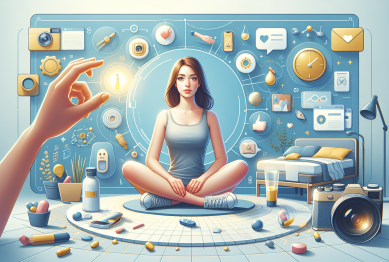Understanding why complex tools can undermine clear thought is now essential for anyone striving for balance, focus, and wellness in a tech-heavy lifestyle.
In a digital world obsessed with optimization, complex tools have become the default. Productivity apps come with layered dashboards. Health trackers monitor everything from sleep cycles to skin temperature. Project management software aims to streamline collaboration through automation, integration, and AI. But somewhere in the pursuit of control, clarity is being compromised.
The promise of complex tools is efficiency—but the reality is often cognitive overload. Instead of simplifying tasks, many of these tools introduce friction, distraction, and decision fatigue. This contradiction is driving a growing backlash: a shift toward simplified systems that support mental clarity, not just digital control.

The Rise of Digital Complexity
Over the past decade, software and systems have evolved rapidly. What began as helpful utilities—simple calendars, to-do lists, or note apps—have become feature-rich ecosystems with learning curves.
This evolution isn’t inherently bad. But it reflects a broader cultural trend: the idea that more features equal more value. The problem arises when those features become mental clutter.
According to a 2023 report by the Center for Humane Technology, nearly 62% of users feel overwhelmed by the very tools designed to help them focus. Tools meant to enhance productivity often demand time to configure, constant updates, and continuous cognitive engagement just to manage them effectively.
Cognitive Load: A Hidden Cost of Complexity
Cognitive load refers to the amount of mental effort used in the working memory. Every button, dropdown, alert, or integration within a tool requires micro-decisions. When these stack up, they impair our ability to focus on the task itself.
A Harvard Business School study found that switching between complex digital tools can reduce performance by up to 40% due to attention residue—the mental drag from constantly changing context.
Signs that a tool is adding too much cognitive load:
-
You spend more time configuring the tool than using it.
-
You need tutorials, plug-ins, or community forums just to perform basic tasks.
-
You feel more exhausted after organizing your system.
Where Complex Tools Fail (And Simpler Ones Succeed)
The core issue isn’t tools themselves—but misalignment between design and purpose. Here’s how complexity tends to backfire:
1. Decision Paralysis
More customization sounds like flexibility, but it can lead to decision fatigue. When there are ten different ways to set up a workspace, users hesitate, tweak endlessly, or abandon it altogether.
2. Reduced Flow State
Constant notifications, syncing issues, or multi-screen navigation interrupt deep work. Complex tools rarely support uninterrupted focus without user intervention.
3. Emotional Drain
When something that’s supposed to help you ends up frustrating you, it can drain emotional energy. This is especially true when tools cause more stress than the tasks they’re managing.
4. Dependency Loops
Advanced systems often require multiple connected apps to work properly. If one fails or updates unexpectedly, your entire workflow may collapse.
Simplicity as a Competitive Advantage
A growing number of professionals, creatives, and wellness advocates are shifting to tools with fewer features, clearer interfaces, and faster onboarding. The goal is not minimalism for its own sake—but mental efficiency.
Popular simplified alternatives:
-
Notepad → Obsidian (without plugins)
-
Google Calendar → Paper-based weekly planner
-
Evernote → Apple Notes
-
Trello/Jira → Whiteboards or single-task apps like Todo.txt
This trend mirrors the rise of digital minimalism, where fewer, focused tools are seen as better for well-being and mental clarity.
How to Identify Tools That Support Clear Thought
Not all digital tools are counterproductive. Some are thoughtfully designed to reduce friction, not increase it. Here’s a guide for choosing tools that align with clarity:
Signs of a Thoughtfully Simple Tool:
-
Clear, intuitive interface without requiring a tutorial.
-
Limited but purposeful feature set.
-
Fast load times and minimal setup.
-
Promotes single-tasking, not constant switching.
-
Works offline or with minimal dependencies.
Red Flags:
-
Requires constant syncing with multiple platforms.
-
Includes gamified elements that nudge you into overuse.
-
Sends frequent, non-essential notifications.
-
Has more community-built plug-ins than actual use cases.
How to Rethink Your Tech Stack
If you’re feeling mentally scattered, your tools might be part of the problem. Here’s a practical process for reviewing and simplifying your systems:
-
List All Tools You Use Weekly
Include apps, platforms, devices, and browser extensions. -
Rate Each on Clarity (1–5)
How well does each tool support clear thinking and low effort use? -
Eliminate or Replace the Low Scorers
Replace bloated systems with simpler ones—even analog options. -
Create Intentional Usage Boundaries
-
Turn off non-essential notifications.
-
Designate tool-free work blocks.
-
Schedule a weekly review for tool maintenance.
-
The Broader Impact on Wellness and Work
Why does this matter beyond productivity?
Because clear thought is a wellness issue. When our brains are overloaded by complexity, we’re more prone to anxiety, poor sleep, burnout, and lower satisfaction. Simplifying our digital environments creates space for rest, reflection, and focused work.
In workplaces, simplified systems lead to:
-
Less onboarding time
-
Higher creative output
-
Reduced stress
-
Better communication and fewer misunderstandings
In personal life, people report feeling “mentally lighter” after reducing digital friction.
A Cultural Moment: Simplicity Is Gaining Momentum
We’re at an inflection point. Across industries, there’s a shift toward designing for clarity. Companies like Superhuman, Minimal, and Not Boring are building experiences around purposeful simplicity rather than feature wars.
Social trends show similar movement. TikTok creators are embracing “tech reset” challenges. Long-form content is making a comeback over algorithm-driven scrolls. Digital detox retreats are booked out months in advance.
This signals a deeper desire—not just to manage information, but to reclaim attention.
Conclusion
The next big breakthrough in productivity and wellness may not be a smarter app—but a simpler one.
If your tools are doing more harm than good, consider this your permission to subtract. Clear thought thrives in clarity of design. And in a culture obsessed with doing more, sometimes the smartest thing you can do is do less—but with more focus.
References
- Center for Humane Technology. (2023). The Hidden Costs of Productivity Tools.
- https://www.humanetech.com
- Harvard Business School. (2022). The Cost of Context Switching in Digital Work.
https://www.hbs.edu - American Psychological Association. (2023). Technology and Mental Health.
https://www.apa.org









